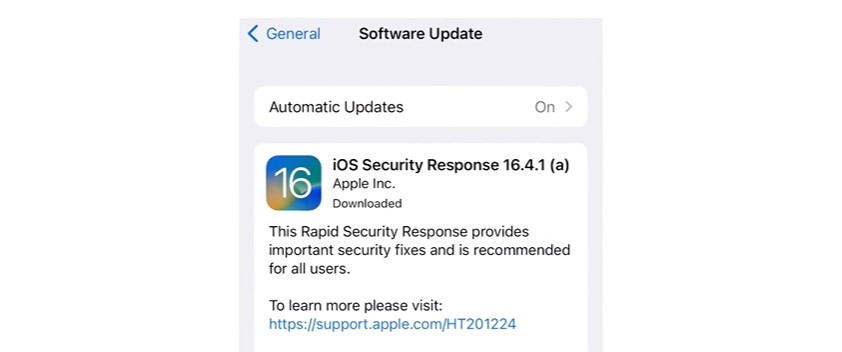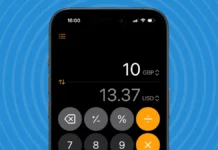
Apple has unveiled an ingenious software known as Rapid Security Response. Rapid Security Responses are solely available for the most recent versions of iOS, iPadOS as well as macOS. This endeavor initiates with iOS 16.4.1 along with iPadOS 16.4.1 as well as macOS 13.3.1, making certain that users of these versions can benefit from the latest security updates in a convenient way. Despite the absence of release notes or any details documenting its contents, this particular update is substantial. The significance lies in the fact that you require it, and here’s why.
Also Read- Cybersecurity And Data Privacy: A Complete Guide
Why Do You Need Rapid Security Response on Your iPhone?
The primary objective of Rapid Security Response is to fortify Apple’s platforms through automated security updates. The underlying concept is that when every user opts for the automatic installation of these patches, the overall ecosystem gains inherent robustness in terms of security.
It is because usually, the process of performing complete OS upgrades can be time-consuming, ushering in delays in securing devices as not all users update promptly as these patches are delivered through larger software updates for iOS, iPadOS, or macOS. Thus, Rapid Security Response addresses the problem of timely distribution and installation of security patches in Apple’s ecosystem.
This update furthermore brings significant security enhancements between software updates, focusing on crucial areas like the Safari web browser, the WebKit framework stack, and other essential system libraries. Additionally, they serve to promptly address security concerns, particularly those that could potentially be exploited or have been reported to exist. This proactive approach guarantees that conceivable vulnerabilities are swiftly mitigated, strengthening the overall security of the system.
If you didn’t know, Apple started testing this feature in October after announcing it at Worldwide Developers Conference 2022. During the testing phase, Apple provided four downloads that didn’t contain any actual content but were utilized to assess the distribution system. The most current test took place in March, while users can activate this feature on devices running the latest operating system, it’s vital to apprehend that Apple has not yet initiated delivering confirmed security patches as of this month.
Also Read- Now With 5 Easy Steps You Can Remove Fake Apple Security Alerts
How To Install The Latest Software Update?
The update will be automatically applied to all Apple users utilizing devices that operate on the most recent version of iOS, iPadOS, or macOS. Alternatively, users furthermore have the option to enable the option to install the update automatically by pursuing the steps provided down below:
On iPhone & iPad
- First, open the Settings app on your iPhone, iPad, or Mac computer.
- Then, you have to go to the General section.
- After that, tap on Software Update under the Settings menu.
- Lastly, select Automatic Updates and ensure that Security Responses & System Files option is enabled.
On Mac
- First, you have to tap on the Apple menu and then head on to select System Preferences.
- Next, click on General in the sidebar.
- Then, on the right-hand side, click on Software Update.
- After that, locate and click the Show Details button next to Automatic Updates.
- Finally, ensure that the option Install Security Responses and system files is turned on.
After turning this feature on, your device will begin continuous monitoring for available security patches. Consequently, whenever a security patch is released, it will be automatically downloaded to your device. Once the system completes the download of the security patch, you will receive a prompt to install it and restart your device.
In addition to that, you can identify the application of a Rapid Security Response by witnessing a letter following the software version number. Apple gave an example by illustrating that it will look like this: macOS 13.3.1 (a).
However, if you decide to disable this setting or choose not to apply Rapid Security Responses when they become available, your device will still receive the necessary fixes or mitigations. These fixes will be included in future software updates that you install.
Also Read- How To Update Apple iOS 14.8 In Your Devices -Apple Security Update
How Can You Remove Rapid Security Response?
If you wish to remove a Rapid Security Response, pursue the steps outlined below. Afterward, you have the option to reinstall the update at a later date or wait for it to be permanently installed through a standard software update.
However, it is consequential to note that removing the Rapid Security Response will potentially leave your iPhone or iPad vulnerable to the exploit or security issue that the update was intended to fix. Thus, it is advised to take this prospect to thoroughly research and resolve the problem that arose when you initially installed the update. Once you have preached the underlying problem, you can reinstall the update to assure the ongoing protection of your device.
Here is how you can remove Rapid Security Response:
- First, you have to head to your phone’s Settings app.
- After that, you have to click on General and then select About.
- Next, you need to click on iOS Version or iPadOS Version.
- Then, you have to look for the option labeled Remove Security Response and tap on it.
- A confirmation prompt will appear so just tap on Remove to confirm the removal process.
Moreover, there are rumors implying that Apple might adopt a monthly security software update release cycle, leveraging Rapid Security Response to enhance security across all its platforms. Besides that, it is intriguing that Apple has the capability to update Safari using this feature. This alludes to the likelihood that in the future, application devs might furthermore have the capability to automate critical security patches for their products. Nonetheless, no official discussions or announcements regarding this matter have taken place yet.
Also Read- Top 6 Security Blunders That Put Your Computer At Risk
Frequently Asked Questions
What devices have Rapid Security Responses?

Apple’s Rapid Security Responses presently support the latest versions of iPhones, iPads as well as Macs. Nonetheless, at present, there is no sign of the capability to provide smaller updates to Apple Watches.
Is the Apple warning real?

No, Apple does not include an integrated antivirus system or conduct malware scans. Consequently, any pop-up virus warnings you encounter are most likely fake and not originating from Apple. Instead, these warnings are typically caused by potentially unwanted applications that have been installed on your Mac. It is possible that you inadvertently launched such applications through deceptive pop-up ads, free software installers, or other third-party file downloads.






































